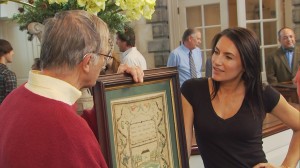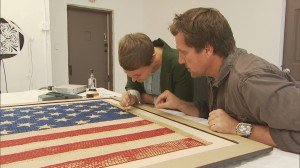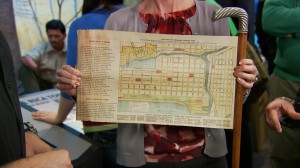A talk with Kinga Philipps from Nat Geo’s ‘America’s Lost Treasures’

Sometimes there’s more than just cobwebs and old report cards hanging out in one’s basement. Amid the dust and dirt could be a small fortune, and National Geographic Channel’s new series, America’s Lost Treasures, wants to find them and learn their history.
Set to premiere Wednesday, July 4 at 9 p.m., America’s Lost Treasures follows co-hosts Kinga Philipps and Curt Doussett as they travel around the United States in search of unique, important and sometimes expensive antiques and artifacts. They choose a few of the best gems from the road and devote an entire episode to finding the story behind each piece of history.
The lucky winners on the show not only compete for a $10,000 prize, but also the chance to have their artifact appear in National Geographic’s museum in Washington, D.C.
Recently, Hollywood Soapbox interviewed Philipps about her journey with the show and the surprises she found on the road. Questions and answers have been slightly edited.
How did you get attached to the project?
I’ve been laughing with everyone at National Geographic that I’ve kind of crossed over from the person who’s a big fan of Nat Geo to actually being a full-time stalker. There’s the backstory that when I was a kid I actually wrote a letter to National Geographic saying, ‘I would love to work with you guys. I want to be one of your explorers.’ And they were lovely and wrote back, ‘That’s great kids. Stay in school. Give us a call later.’ And I did.

When this project came up, and it was this beautiful combination of entertainment and an intelligent program, something that was really fascinating, I certainly wasn’t someone who was just casually throwing my name in the ring. I was the one that had my hand up going, ‘Pick me! Pick me! Pick me!’ And they did, and I’m grateful for that. And I know that my esteemed co-host Curt Doussett felt the same way, and he has a background in history.
Did you have to educate yourself on these lost treasures?
My background is journalism. So the research for something like this is part of the process, and it’s something that I love. But, yes, of course, the items that we saw coming in were so vast and so varied. I mean we had everything from dresses from the turn of the century to guns to props to … shark teeth to so many different things.
It is not humanly possible to be an expert on all of these items. Which is why along the way in these museums we had experts come along with us to help us make educated decisions on some of these items. Both Curt and I have enough of a background that we can walk in, take a look at something and say, ‘You know what? This is a fascinating piece. We want to research it further.’ But it is definitely nice to have someone there who is an art historian per say when we’re looking at a beautiful piece of art, or someone who deals with vintage clothing that can say, ‘Yes, this is truly fascinating. It could be valuable. Let’s look further.’ And then, of course, we have the amazing people who helped us authenticate these items. We did a lot of back research, because that is part of the process. This is National Geographic; they do things well; they do things right.
How long did it take to produce an episode?
We shot over four days. … What was fascinating about this show that I have not seen in other shows that I’ve been a part of is that a lot of research happened in real time. We would come into a city, and we would spend the first day in the museum. People would come in; they would bring us their items. We were there all day long, speaking to everyone, taking a look at what they have, speaking to our experts and then selecting the items in which we would then investigate further.
Then we spent the next two days actually doing research and investigation. But obviously a lot of this had to be set up in advance. We had people on standby depending on what we would pick to help us do this research and authenticate the items. And then there was the pre-production of us knowing that there would be certain things that were coming in. Otherwise we would just have no idea and we would end up with 400 items that we would have to sort through. So a large part of the sorting process has to be done beforehand, but then the rest of it happened in real time and that was fun. It was an experience, and I think that’s what makes the show so fun and different is that the audience gets to be part of this real-time experience with us.

Could you talk about working with your co-host, Curt Doussett?
Well, I have to say, Curt Doussett is just an amazing human being. … We had never met before, and instantly just became great friends. And for a show like this, you have to have that natural chemistry. We honestly have the rivalry and relationship of two siblings who have so much respect for each other and have such a great time, and would bicker and compete along the way, because that’s the part of the show, this competition between Curt and I.
There’s entertainment and then there’s these informative shows that come along that I think have been a big part of the genre that National Geographic and those types of programs really promote. This one crosses over into that infotainment, which I think really grabs people. Because you are learning something and it is fascinating, and we’re doing a lot of research and it’s incredibly interesting. It also brings to light a lot of personality, not just mine and Curt’s, but the people who come in. They are such characters.
What were some of your biggest surprises with the series?
There were surprises along every turn. Some of the surprises were in the people who came in. They were hysterical. They were so fun. Some of them had profound stories. There were a lot of tears shed, unexpected moments. With the items themselves, there were ordeals as far as monetary value or something that we thought was maybe, ‘Oh, this is neat,’ and it turned out to be an incredibly significant piece. And then there were a lot of letdowns. There were a few moments where I thought, OK, I’ve got something. This is going to be the winner this week. I have something that’s incredible. We went in and did the research and found out that something was a fake.
I had to tell someone that the item that they paid a lot of money for, and thought was a real deal, actually wasn’t. And then on the flip side, there were moments when I got to come to someone and say, ‘Listen, you have a treasure on your hands. This is way bigger than you thought it was.’
Were there conversations among the production team about making the series stand out from similar shows?
I remember the magical words of Thom Beers, head of Original Productions, who said to me, ‘You know, to be at the top of this business, you don’t just want to do something better, you have to do it best.’ And I thought, oh, that’s why you’re Thom Beers. I’ll write that down. And it’s true, there are a lot of similar shows out there on TV in every respect. But you’re always striving as a creative individual, whether a producer, whether an on-camera host, to really do something that takes it to the next level, that brings something to people that they haven’t seen before, and I think we did a good job of that.
How about a second season?
In the TV world, I think the proper protocol is to cross all of your fingers and toes and hope that we move on. I personally think this is a great show. This is one of those shows that you are excited to be a part of, and when you see it completed, you go, ‘OK, we have something great on our hands.’ And I know National Geographic is very excited about it. I know Original Productions is very excited about it. And we hope that the audience is, too.
Were the museum curators excited to be involved?
They were so excited to be involved, and they were so wonderful. And part of what this series does so well is, I think, it makes museums cool. I grew up going to museums. I love museums. But I think what this show does is it really brings to light how fascinating and diverse and unique some of these museums across the country are, and then on top of that, we get to go into the bowels of these museums, into these research laboratories and take it to yet another level that sometimes people don’t get to see. They don’t even know that they have these amazing storage centers of all the items not on display, and these incredible research facilities to authenticate items and really do all the tests on them. We get to see and show all of that behind-the-scenes work. And the curators of the museums were some of the most fascinating, fun, interesting, intelligent, just awesome individuals that we met along the way.
Can audience members expect a big discovery in the first season?
There are so many surprises along the way. … There are new things that are going to be discovered in this series that we actually are keeping hush-hush until the series comes out.
On top of that, they have everything to look forward to from books made out of human skin to trucks and guns and incredible representations of our country’s history. There are going to be some big ‘Wow’ moments.
By John Soltes / Publisher / John@HollywoodSoapbox.com
-
America’s Lost Treasures premieres July 4 at 9 p.m. on National Geographic Channel. Click here for more information.


I was one of the “characters” filmed for the show. What a terrific experience I had with the Curt and Kinda and the outstanding crew from Original Productions. This show is sure to be a big hit. It has what everyone is looking for and done in a very entertaining and educational venue. For me it had nothing to do with winning. It was all about incredible information the expert at the museum was able to tell me the dinosaur bone found by my father 73 years ago. Finding out what kind of bone it was is “priceless.” Kinga and Curt “You Rock!”
found a lot of items on Sitka back in 1980’s metal detecting. One item was declared priceless by Sitka National Park staff. A lead furring seal with name of Russian Capitol. I signed a paper loaning the item to the park. Would this qualify as an item to look at in your show? I have never seen the seal since then and wonder if they put it on display as they said they were going to do or its sitting in some closet somewhere. Tony Rasmus